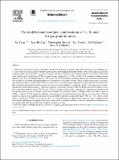Files in this item
The molybdenum isotopic compositions of I-, S- and A- type granitic suites
Item metadata
| dc.contributor.author | Yang, Jie | |
| dc.contributor.author | Barling, Jane | |
| dc.contributor.author | Siebert, Christopher | |
| dc.contributor.author | Fietzke, Jan | |
| dc.contributor.author | Stephens, Ed | |
| dc.contributor.author | Halliday, Alex N. | |
| dc.date.accessioned | 2017-03-08T12:30:13Z | |
| dc.date.available | 2017-03-08T12:30:13Z | |
| dc.date.issued | 2017-05-15 | |
| dc.identifier | 249036438 | |
| dc.identifier | 7e0b9716-87a3-45d3-9309-3f71b515fd55 | |
| dc.identifier | 85014541515 | |
| dc.identifier | 000402487700010 | |
| dc.identifier.citation | Yang , J , Barling , J , Siebert , C , Fietzke , J , Stephens , E & Halliday , A N 2017 , ' The molybdenum isotopic compositions of I-, S- and A- type granitic suites ' , Geochimica et Cosmochimica Acta , vol. 205 , pp. 168-186 . https://doi.org/10.1016/j.gca.2017.01.027 | en |
| dc.identifier.issn | 0016-7037 | |
| dc.identifier.other | RIS: urn:E1CCAA63B7A521AA2EFA5263863E4036 | |
| dc.identifier.other | ORCID: /0000-0002-0884-8722/work/65013848 | |
| dc.identifier.uri | https://hdl.handle.net/10023/10413 | |
| dc.description | JY is funded by a Clarendon Scholarship and a Dr Bill Willetts Scholarship from the University of Oxford. The research leading to these results has received funding from the European Research Council under the European Union's Seventh Framework Programme (FP7/2007-2013) / ERC grant agreement No. 247422. This work has also supported by Science & Technology Facilities Council. | en |
| dc.description.abstract | This study reports Mo isotopic compositions for fifty-two Palaeozoic granitic rocks with contrasting source affinities (A-, I- and S-type) from the Lachlan Fold Belt (LFB) and the New England Batholith (NEB), both in SE Australia, and three compositionally zoned plutons (Loch Doon, Criffell, and Fleet) located in the South Uplands of Scotland. The results show relatively large variations in δ98Mo for igneous rocks ranging from -1.73‰ to 0.59‰ with significant overlaps between different types. No relationships between δ98Mo and δ18O or ASI (Alumina Saturation Index) are observed, indicating that Mo isotopes do not clearly distinguish igneous versus sedimentary source types. Instead, effects of igneous processes, source mixing, regional geology, as well as hydrothermal activity control the Mo isotope compositions in these granites. It is found that Mo is mainly accommodated in biotite and to a lesser extent in hornblende. Hornblende and Fe3+-rich minerals may preferentially incorporate light isotopes, as reflected by negative correlations between δ98Mo and K/Rb and [Fe2O3]. There is a positive correlation between initial 87Sr/86Sr and δ98Mo in I-type granitic rocks, reflecting the admixing of material from isotopically distinct sources. Granitic rocks from Scotland and Australia display strikingly similar curvilinear trends in δ98Mo vs. initial 87Sr/86Sr despite the differing regional geology. Localized hydrothermal effects on Mo isotopes in three samples from Loch Doon and Criffell can result in anomalously low δ98Mo of < -1‰. Based on this study, an estimate of δ98Mo = 0.14±0.07‰ (95% s.e.) for the Phanerozoic upper crust is proposed. This is slightly heavier than basalts indicating an isotopically light lower crust and / or a systematic change to the crust resulting from subduction of isotopically light dehydrated slab and / or pelagic sediment over time. | |
| dc.format.extent | 19 | |
| dc.format.extent | 2236598 | |
| dc.language.iso | eng | |
| dc.relation.ispartof | Geochimica et Cosmochimica Acta | en |
| dc.subject | Molybdenum isotopes | en |
| dc.subject | Granitic rock | en |
| dc.subject | Granite | en |
| dc.subject | A-type | en |
| dc.subject | I-type | en |
| dc.subject | S-type | en |
| dc.subject | Lachlan Fold Belt | en |
| dc.subject | Loch Doon | en |
| dc.subject | Criffell | en |
| dc.subject | Fleet, the upper crust | en |
| dc.subject | GE Environmental Sciences | en |
| dc.subject | QD Chemistry | en |
| dc.subject | NDAS | en |
| dc.subject.lcc | GE | en |
| dc.subject.lcc | QD | en |
| dc.title | The molybdenum isotopic compositions of I-, S- and A- type granitic suites | en |
| dc.type | Journal article | en |
| dc.contributor.institution | University of St Andrews. Earth and Environmental Sciences | en |
| dc.contributor.institution | University of St Andrews. St Andrews Isotope Geochemistry | en |
| dc.contributor.institution | University of St Andrews. School of Geography and Geosciences | en |
| dc.identifier.doi | 10.1016/j.gca.2017.01.027 | |
| dc.description.status | Peer reviewed | en |
This item appears in the following Collection(s)
Items in the St Andrews Research Repository are protected by copyright, with all rights reserved, unless otherwise indicated.

